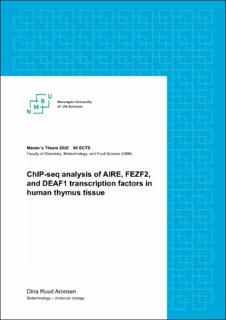| dc.contributor.advisor | Lie, Benedicte A. | |
| dc.contributor.advisor | Ribarska, Teodora | |
| dc.contributor.advisor | Bøhn, Siv Kjølsrud | |
| dc.contributor.author | Aronsen, Dina Ruud | |
| dc.date.accessioned | 2020-10-16T10:19:01Z | |
| dc.date.available | 2020-10-16T10:19:01Z | |
| dc.date.issued | 2020 | |
| dc.identifier.uri | https://hdl.handle.net/11250/2683302 | |
| dc.description.abstract | Autoimmune diseases develop as a consequence of incorrect establishment of self-tolerance. A key element in this process is the presentation of tissue-restricted antigens (TRA) by medullary thymic epithelial cells (mTECs) and antigen presenting cells (APCs) to the developing T-cells in the thymus. TRA expression is mostly driven by the transcription factors Autoimmune regulator (AIRE) and Forebrain Embryonic Zinc Finger-Like Protein 2 (FEZF2) in mTECs. Deformed Epidermal Autoregulatory Factor 1 Homolog (DEAF1), present in all thymic APCs, is suggested to also control TRA expression as it does in the lymph node. The purpose of this study was to establish and optimise chromatin immunoprecipitation (ChIP) method for use in human freshly frozen thymus tissues and apply it to determine the genomic binding sites of FEZF2, AIRE and DEAF1 in the infant human thymus in order to better understand the molecular mechanism of T-cell self-tolerance establishment. Aiming to reach the highest possible sensitivity and specificity of the enrichment, we optimised the ChIP procedure using homogenised frozen human thymic tissue (n=3) by testing the parameters: fixation (single or double crosslinking), fragmentation by sonication, antibody type and amount, and immunoprecipitation conditions. The optimal ChIP conditions were found to be: 1) Fixation for 5 min with 1 % formaldehyde and 2.5 mM disuccinimidyl glutarate with 20-30 mg tissue powder ; 2) Sonication to 300-500 bp average DNA fragment size; 3) IP with 5 μg anti-AIRE (GeneTex), 5 μg anti-DEAF1 (LSBio), and 1 μg FEZF2 (Abcam) per 100 μl chromatin (out of 2 mL chromatin isolated from 20-30 mg tissue powder) using 30 μl protein G magnetic beads (Dynabeads) per IP reaction. These condition provided the highest specific recovery of target regions for the three transcription factors, measured by qPCR. The optimal conditions were used in a pilot ChIP-seq experiment to locate binding sites of the transcription factors. Analysis of AIRE, FEZF2, and DEAF1 ChIP-seq data from human thymus and qPCR of ChIP using TEC and APC enriched cell sample isolated from half of a thymus showed low enrichment of target genes, which may be caused by scarcity of cells expressing AIRE, FEZF2, and DEAF1 in bulk thymus tissue or enriched for mTEC and APC thymus cell suspension. To assess the function of AIRE, FEZF2, and DEAF1 in mTECs and thymic APCs, further exploration using CUT&Tag or ChIP-seq will be needed using mTEC and APC enriched cell solution. | en_US |
| dc.language.iso | eng | en_US |
| dc.publisher | Norwegian University of Life Sciences, Ås | en_US |
| dc.rights | Attribution-NonCommercial-NoDerivatives 4.0 Internasjonal | * |
| dc.rights.uri | http://creativecommons.org/licenses/by-nc-nd/4.0/deed.no | * |
| dc.subject | T-cell | en_US |
| dc.subject | thymic epithelial cell | en_US |
| dc.subject | Transcription factor | en_US |
| dc.subject | ChIP-seq | en_US |
| dc.title | ChIP-seq analysis of AIRE, FEZF2 and DEAF1 transcription factors in human thymus tissue | en_US |
| dc.title.alternative | ChIP-seq analyse av AIRE, FEZF2 og DEAF1 transkripsjonsfaktorer i humant brisselvev | en_US |
| dc.type | Master thesis | en_US |
| dc.description.version | submittedVersion | en_US |
| dc.subject.nsi | VDP::Technology: 500::Biotechnology: 590 | en_US |
| dc.source.pagenumber | 98 | en_US |
| dc.relation.project | Norges forskningsråd: 274718 | en_US |
| dc.description.localcode | M-BIOTEK | en_US |

